Y-12 Blog
When it’s time to perform factory acceptance testing on a critical technology during a pandemic, what do you do? Since the product still must be delivered, you adapt by monitoring the work remotely.
Pre-pandemic, CNS and NPO staff would have sent several people on multiple trips to observe electrorefining testing. This time, because of COVID restrictions on the number of people allowed in the shop, the project team could only send two representatives.
With limited access and high stakes - electrorefining is key for uranium processing - the project team had to figure out how more of them could view the testing. By purchasing some iPads and communicating via WebEx, the team remaining in Oak Ridge could effectively monitor the testing and communicate with the team members at the vendor’s site. Project manager Steve Cruz said, “We had a learning curve with WebEx, but it was manageable.”
From a conference room in Jack Case Center, the NNSA customer and Production team members were able to monitor the testing that was being conducted across the country in one of Merrick’s facilities. In fact, some team members were able to view the testing from their computers on site or while teleworking.
Cruz thinks viewing factory acceptance testing remotely may be advisable even when travel isn’t restricted. “With remote viewing, staff who only need to see a small portion of the testing can do so without the expense of travel,” he said. The remote viewing also allows parties who are interested to witness the testing, too, which may be helpful to train staff to observe such tests in the future.
Remote testing may have been born of necessity, but the benefits, including reduced travel costs and ease of staff participation, may remain when we reach the “new normal.” Watch this short video (closed captioned version) for more information.
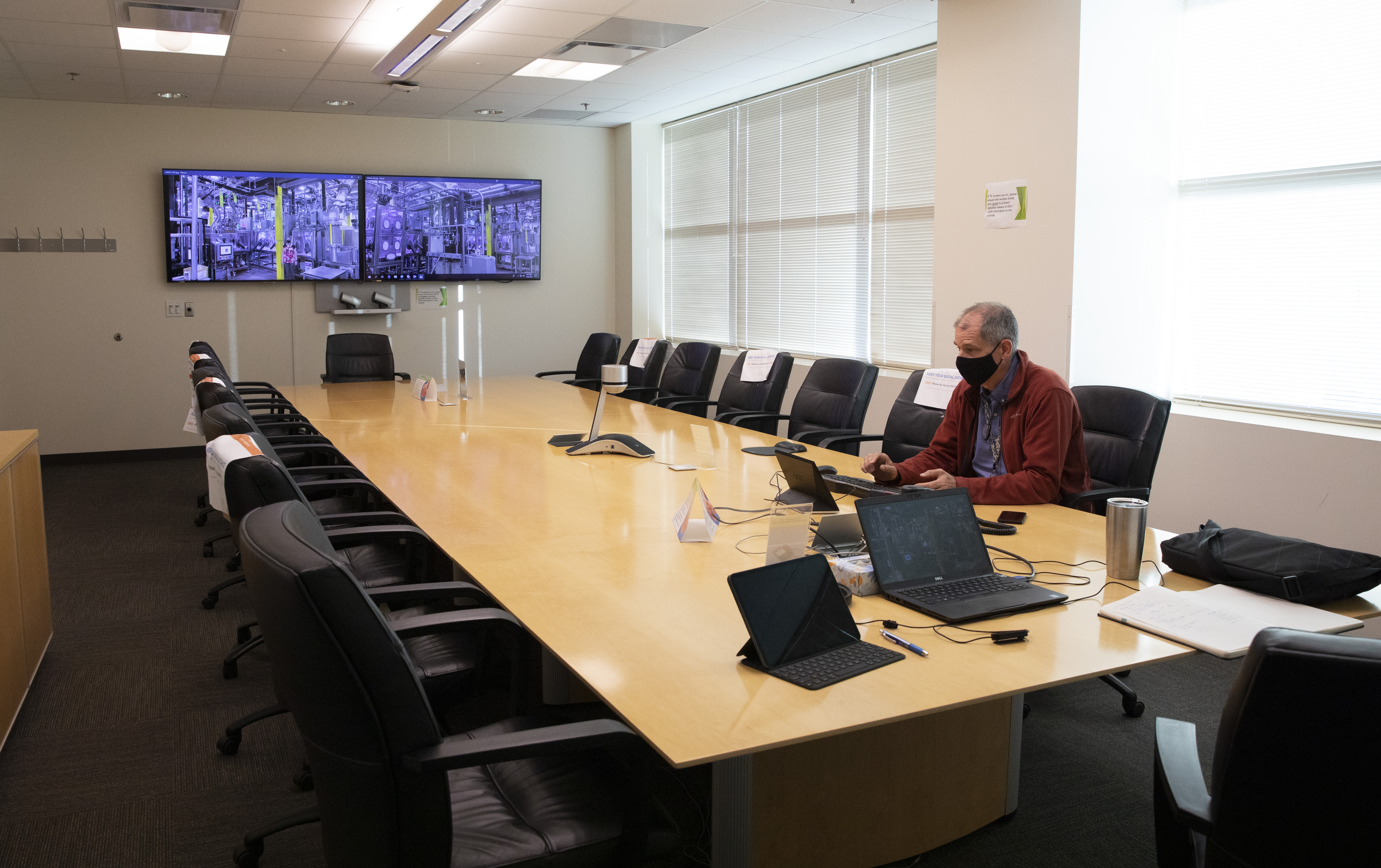
Project manager Steve Cruz participates in factory acceptance testing for electrorefining remotely.
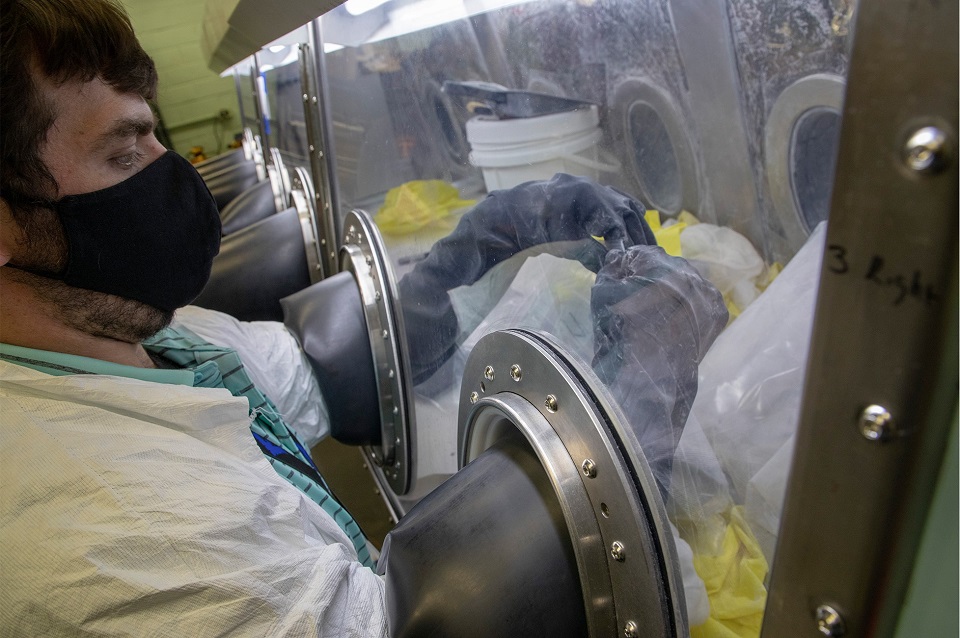
Development’s Trevor Roberts, Direct Material Manufacturing lead, isolates several key samples to be sent to Y-12’s Analytical Chemistry Organization.
The National Nuclear Security Administration’s (NNSA’s) Office of Defense Nuclear Nonproliferation (DNN) works globally to prevent state and non-state actors from developing nuclear weapons or acquiring weapons-usable nuclear or radiological materials, equipment, technology, and expertise. Through the Office of DNN Research and Development (DNN R&D), NNSA advances its nuclear threat reduction mission by developing ways to detect and monitor foreign nuclear fuel cycle and weapons development activities.
This summer Development, the Analytical Chemistry Organization, Program Integration, Mission Engineering, and Environment, Safety, and Health leveraged ongoing Direct Material Manufacturing and completed the second campaign in isolating select lithium samples.
Consolidated Nuclear Security (CNS) Chief Scientist Greg Schaaff said, “When people think of nuclear nonproliferation and forensics, most think of the production and use of uranium and plutonium materials. However, the production of lithium compounds are central to civilian energy and military applications.”
Matthew W. Francis is the Pantex and Y-12 contact with DNN R&D. He said, “Using Y-12’s lithium processing and applications core capabilities, DNN R&D has funded a collaboration between CNS, Lawrence Livermore National Laboratory, and Los Alamos National Laboratory to determine potential signatures capable of differentiating between civilian and weapon applications of lithium compounds.”
“In our initial subsampling campaign in FY19, we had to overcome many challenges along the way,” said Jason McCall, program manager of Global Security and Strategic Partnership Programs. “Challenges included failed coring tools, answering questions on contamination, and coordinating with other projects in regards to schedule and priority. Trevor Roberts was essential in getting us through these challenges, as well as many others. By the time we started ramping up the second subsampling campaign in FY20, our initial challenges were a distant memory. Trevor and the entire Direct Material Manufacturing team were key in making our subsampling campaign a success.”
Following the subsampling efforts (which is when a sample is drawn from a larger sample), several lithium samples were shipped to ACO to run through several measurement methods to identify a variety of trace elements.
“ACO sees many new matrices that push our current analytical capabilities,” Tom Oatts, ACO lab supervisor, said. “Through the use of innovative approaches to existing lab methods, Sarah Slack and other ACO team members can push these capabilities to meet our customers’ needs and requirements.”
Francis said, “While this project is still ongoing, accomplishing these campaigns was essential for the overall success of the project. This effort could not have been executed if it wasn’t for the great collaboration across the various Y-12 organizations.”
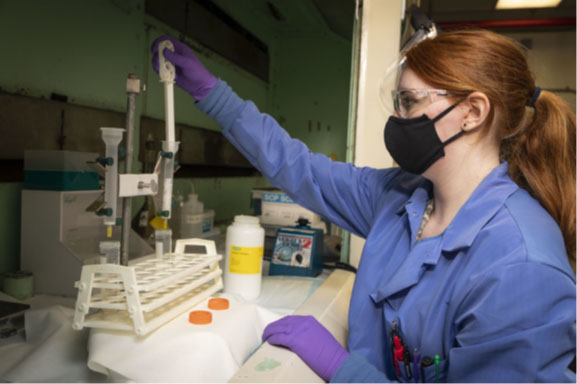
Sarah Slack of the Analytical Chemistry Organization separates key trace elements that potentially could be used for differentiating between interdicted lithium samples.
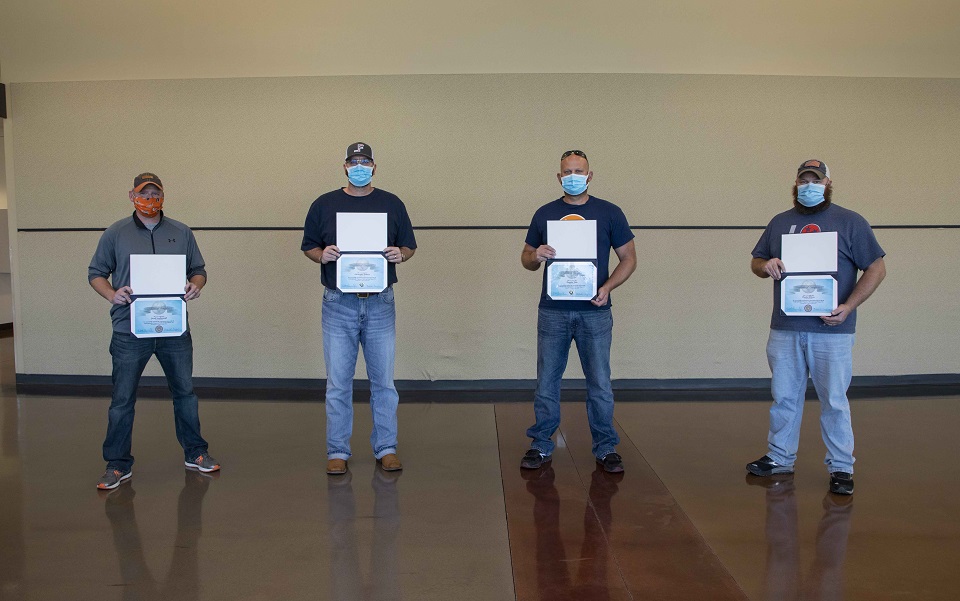
Y-12 Apprenticeship Program 2020 graduates present their diplomas. From left: Jacob Scarborough, electrician; Christopher Drinnon, pipefitter; Brandon Muir, pipefitter; and Dustin Wilson, electrician.
After 13 years as a Y-12 laborer, Christopher Drinnon acted on his father’s advice: “You should get in a trade.” Now a recent pipefitter apprentice graduate, Drinnon graduated on October 6 from the Y-12 Apprenticeship Program alongside three skilled journeymen, one pipefitter and two electricians.
Since 2008, Y-12 has celebrated 97 graduates and eight graduation ceremonies in the program. Before graduation, each apprentice is trained to union specifications for journeymen level classification upon completion of the program. In addition to qualifications, apprentices learn from experiential training opportunities and work three month rotations in different workshops throughout Y-12. Through these experiences, apprentices gain valuable knowledge in their field and on site.
“The Apprenticeship Program has positioned Y-12 for long term mission support, at a time when skilled craft workers are in high demand,” said Will Farmer of Y-12 Infrastructure. “Our program is a great way to transfer knowledge from highly skilled workers to the new workforce and is our guarantee that we will be able to meet our future production goals,” he continued.
A combined partnership between CNS and the Atomic Trades and Labor Council, the Apprenticeship Program is registered with the Department of Labor as well as the Veterans Administration. Y-12’s Joint Apprenticeship and Training Committee is also involved to guarantee the welfare of the program by meeting each month to address various topics on how to grow and assist the program.
Apprentice supervisor and JATC member Zach Yost said, “Our committee exists to ensure that we’re nurturing unsurpassed talent for our program. Today, it’s safe to say that we’ve found that here with our 2020 class.”
The graduates also were recognized for not only their hard work but also the sacrifices that were made by the apprentices and their families.
“The main lesson was not to give up,” said Brandon Muir, Y-12 pipefitter. “The experience was an adjustment; adding 3.5 hour classes, two nights per week on top of a 10 hour day was challenging.
That’s not counting my commute and having a new baby, but the on-the-job training made it worth it.”
In honoring the graduates, Y-12 Site Manager Gene Sievers emphasized the significance the skilled trades have on the mission and the development of the men and women who follow in their footsteps.
“Being skilled in the art is extremely important,” he said. “Your knowledge and capabilities are foundational for Y-12’s enduring mission, our national security, and the future generation of skilled trades.”
With milestones met, Y-12’s four new journeymen will progress to a new chapter making their impact to on site operations and continuing the legacy and strength of our workforce.
“This is a great accomplishment for you, CNS, and our union. This is something that can never be taken from you and will provide you a path to a career that you can be proud of,” said ATLC President Mike Thompson. “I know and appreciate the sacrifices you have made to achieve this graduation. But it doesn’t end here. You will continue to learn and become more proficient in your skills. The responsibility you face couldn’t be more important. You are the ones who will take our place and carry on the proud tradition of being some of the most skilled tradesmen in the world.”
Consolidated Nuclear Security, LLC (CNS) is demonstrating a continued commitment to business partnership, even in the midst of the COVID-19 pandemic. As part of ongoing outreach to business owners and potential vendors, CNS representatives are continuing their Partners in Excellence (PIE) event series virtually.
CNS began the PIE event series in April 2018 because the government contract solicitation process is sometimes considered complex or cumbersome for businesses, particularly newcomers and small businesses.
The latest round of online PIE workshops and forums allow potential business partners to attend while adhering to local social distancing guidelines in Texas, Tennessee, and across the country. PIE workshops are targeted based on agenda content, but larger events like the recent August PIE forum are open to a broader audience of business owners.
“Our goal is to increase the capacity and capability of our contractor base to support our small project execution,” said Cindy Morgan, director of CNS Supply Chain Business Management. “In our world, small projects are defined as $50 million or less.”
While CNS has a focus on modernizing the aging infrastructure of Pantex and Y-12, the company doesn’t only need construction contractors.
“We purchase a variety of goods and services from small and large businesses, and we need vendors for everything from general office supplies to information technology and staff augmentation,” said Randy Crawford, Pantex Small Business Program Manager.
The PIE events are a chance for CNS leaders to offer attendees a slice of knowledge about successfully doing business with Pantex and Y-12, break down the requirements, and share upcoming opportunities. During the August 29 PIE event, Bill Tindal, the CNS chief operating officer, provided an overview of the Pantex and Y-12 site histories and explained why the company uses subcontractors as partners.
There’s also a chance to network with fellow business owners to encourage partnerships. “Sometimes a small business is not able to bond for a large job, but they have the expertise and skills that a larger business does not,” said Morgan. “Providing a chance to network encourages those businesses to work together and submit a joint bid.”
Each year, CNS awards over $1 billon in subcontracts to businesses that help accomplish specialized tasks in support of its vital national security mission.
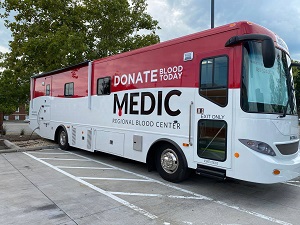
MEDIC’s newest bus was used for September’s mobile blood drive events at Y-12.
More Y-12 employees rolled up their sleeves in September to meet the growing need for blood donations in East Tennessee.
During a typical month, @ MEDIC Regional Blood Center holds one donation event at Y-12 and collects about 70 units of blood. In September, MEDIC requested a second event due to a higher demand for blood in the region. Thanks to Y-12ers generously giving the Gift of Life, MEDIC collected 131 units during the month’s two donation events, which were held in MEDIC buses parked outside New Hope Center. #CNSCares #GiveBlood
